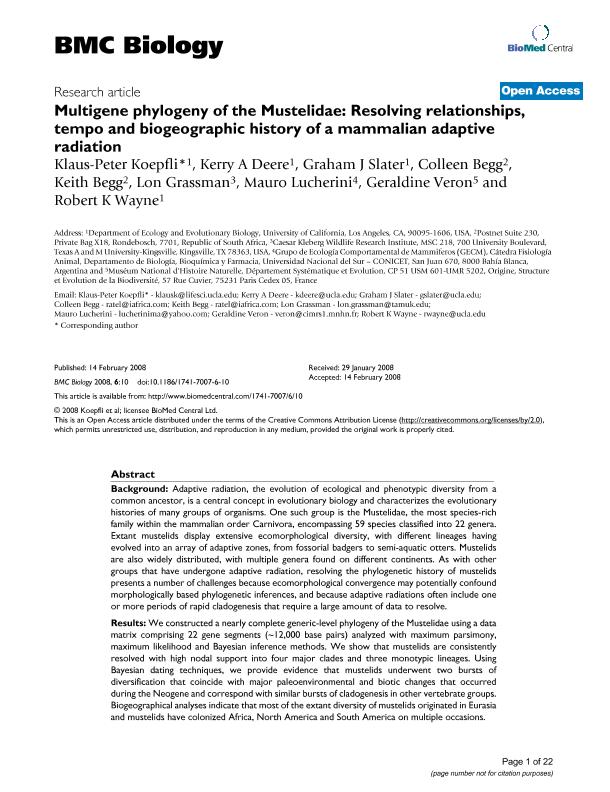Mostrar el registro sencillo del ítem
dc.contributor.author
Koepfli, Klaus Peter
dc.contributor.author
Deere, Kerry A.
dc.contributor.author
Slater, Graham J.
dc.contributor.author
Begg, Colleen
dc.contributor.author
Begg, Keith
dc.contributor.author
Grassman, Lon
dc.contributor.author
Lucherini, Mauro

dc.contributor.author
Veron, Geraldine
dc.contributor.author
Wayne, Robert K.
dc.date.available
2019-04-26T16:29:19Z
dc.date.issued
2008-02-14
dc.identifier.citation
Koepfli, Klaus Peter; Deere, Kerry A.; Slater, Graham J.; Begg, Colleen; Begg, Keith; et al.; Multigene phylogeny of the Mustelidae: Resolving relationships, tempo and biogeographic history of a mammalian adaptive radiation; BioMed Central; Bmc Biology; 6; 14-2-2008; 10-32
dc.identifier.issn
1741-7007
dc.identifier.uri
http://hdl.handle.net/11336/75084
dc.description.abstract
Background: Adaptive radiation, the evolution of ecological and phenotypic diversity from a common ancestor, is a central concept in evolutionary biology and characterizes the evolutionary histories of many groups of organisms. One such group is the Mustelidae, the most species-rich family within the mammalian order Carnivora, encompassing 59 species classified into 22 genera. Extant mustelids display extensive ecomorphological diversity, with different lineages having evolved into an array of adaptive zones, from fossorial badgers to semi-aquatic otters. Mustelids are also widely distributed, with multiple genera found on different continents. As with other groups that have undergone adaptive radiation, resolving the phylogenetic history of mustelids presents a number of challenges because ecomorphological convergence may potentially confound morphologically based phylogenetic inferences, and because adaptive radiations often include one or more periods of rapid cladogenesis that require a large amount of data to resolve. Results: We constructed a nearly complete generic-level phylogeny of the Mustelidae using a data matrix comprising 22 gene segments (∼12,000 base pairs) analyzed with maximum parsimony, maximum likelihood and Bayesian inference methods. We show that mustelids are consistently resolved with high nodal support into four major clades and three monotypic lineages. Using Bayesian dating techniques, we provide evidence that mustelids underwent two bursts of diversification that coincide with major paleoenvironmental and biotic changes that occurred during the Neogene and correspond with similar bursts of cladogenesis in other vertebrate groups. Biogeographical analyses indicate that most of the extant diversity of mustelids originated in Eurasia and mustelids have colonized Africa, North America and South America on multiple occasions. Conclusion: Combined with information from the fossil record, our phylogenetic and dating analyses suggest that mustelid diversification may have been spurred by a combination of faunal turnover events and diversification at lower trophic levels, ultimately caused by climatically driven environmental changes. Our biogeographic analyses show Eurasia as the center of origin of mustelid diversity and that mustelids in Africa, North America and South America have been assembled over time largely via dispersal, which has important implications for understanding the ecology of mustelid communities.
dc.format
application/pdf
dc.language.iso
eng
dc.publisher
BioMed Central

dc.rights
info:eu-repo/semantics/openAccess
dc.rights.uri
https://creativecommons.org/licenses/by/2.5/ar/
dc.subject
Markov Chain Monte Carlo
dc.subject
Maximum Parsimony
dc.subject
Adaptative Radiation
dc.subject
American Mink
dc.subject
High Posterior Density
dc.subject.classification
Biología Celular, Microbiología

dc.subject.classification
Ciencias Biológicas

dc.subject.classification
CIENCIAS NATURALES Y EXACTAS

dc.title
Multigene phylogeny of the Mustelidae: Resolving relationships, tempo and biogeographic history of a mammalian adaptive radiation
dc.type
info:eu-repo/semantics/article
dc.type
info:ar-repo/semantics/artículo
dc.type
info:eu-repo/semantics/publishedVersion
dc.date.updated
2019-03-27T13:29:57Z
dc.journal.volume
6
dc.journal.pagination
10-32
dc.journal.pais
Reino Unido

dc.journal.ciudad
Londres
dc.description.fil
Fil: Koepfli, Klaus Peter. University of California; Estados Unidos
dc.description.fil
Fil: Deere, Kerry A.. University of California; Estados Unidos
dc.description.fil
Fil: Slater, Graham J.. University of California; Estados Unidos
dc.description.fil
Fil: Begg, Colleen. No especifica;
dc.description.fil
Fil: Begg, Keith. No especifica;
dc.description.fil
Fil: Grassman, Lon. Caesar Kleberg Wildlife Research Institute; Estados Unidos. Texas A&m University Kingsville; Estados Unidos
dc.description.fil
Fil: Lucherini, Mauro. Consejo Nacional de Investigaciones Científicas y Técnicas. Centro Científico Tecnológico Conicet - Bahía Blanca; Argentina. Universidad Nacional del Sur. Departamento de Biología, Bioquímica y Farmacia; Argentina
dc.description.fil
Fil: Veron, Geraldine. Muséum National d'Histoire Naturelle; Francia
dc.description.fil
Fil: Wayne, Robert K.. University of California; Estados Unidos
dc.journal.title
Bmc Biology

dc.relation.alternativeid
info:eu-repo/semantics/altIdentifier/url/https://bmcbiol.biomedcentral.com/articles/10.1186/1741-7007-6-10
dc.relation.alternativeid
info:eu-repo/semantics/altIdentifier/doi/http://dx.doi.org/10.1186/1741-7007-6-10
Archivos asociados
